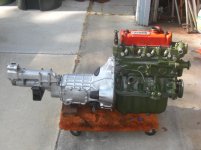At 9:45 PM this evening, Baby Blue came back to life. It took a little bit of cranking, but she turned over and was idling without any choke (maybe carbs too rich?). The motor woke my daughter up and she became VERY excited when she heard the car's motor going again.
It wasn't 100% smooth. I was getting some bizarre readings when I ran a compression test and the results were not consistent when I the test on the same cylinder. I'm thinking that I still have to do some adjusting to the valves possibly. By bizarre, they were either high, such as 160 psi in the #3 cylinder, when the p.o. had a max of 150, and then only reading 90 psi in cylinder 1, which was the "good" cylinder. It's possible this may be user error. I'm also thinking the the valves may still need some adjusting.
I also realized that I forgot to order the cable pinch bolt for the choke cable, and I had lost the original when it fell, hit the floor and disappeared. I wasn't going to be denied. I quickly discovered that a pinch bolt from a set of cantilever bicycle brakes that I had lying around would fit the carburetor perfectly. Yes, I will get the proper bolt the next time I have to order parts, but for now, it works.
I do plan on changing the air filters, but for the life of me, I can't figure out how to get to them. I'm guessing you need to take the center bolt off? I also still need to check the timing, recheck the valves, reset the carburetor, and of course, put the hood back on, but the engine is running!
There are no words that can adequately express my gratitude to everyone's helpful hints and advice. Thank you, thank you, thank you!

 Hi Guest!
Hi Guest!

 smilie in place of the real @
smilie in place of the real @
 Pretty Please - add it to our Events forum(s) and add to the calendar! >>
Pretty Please - add it to our Events forum(s) and add to the calendar! >> 




